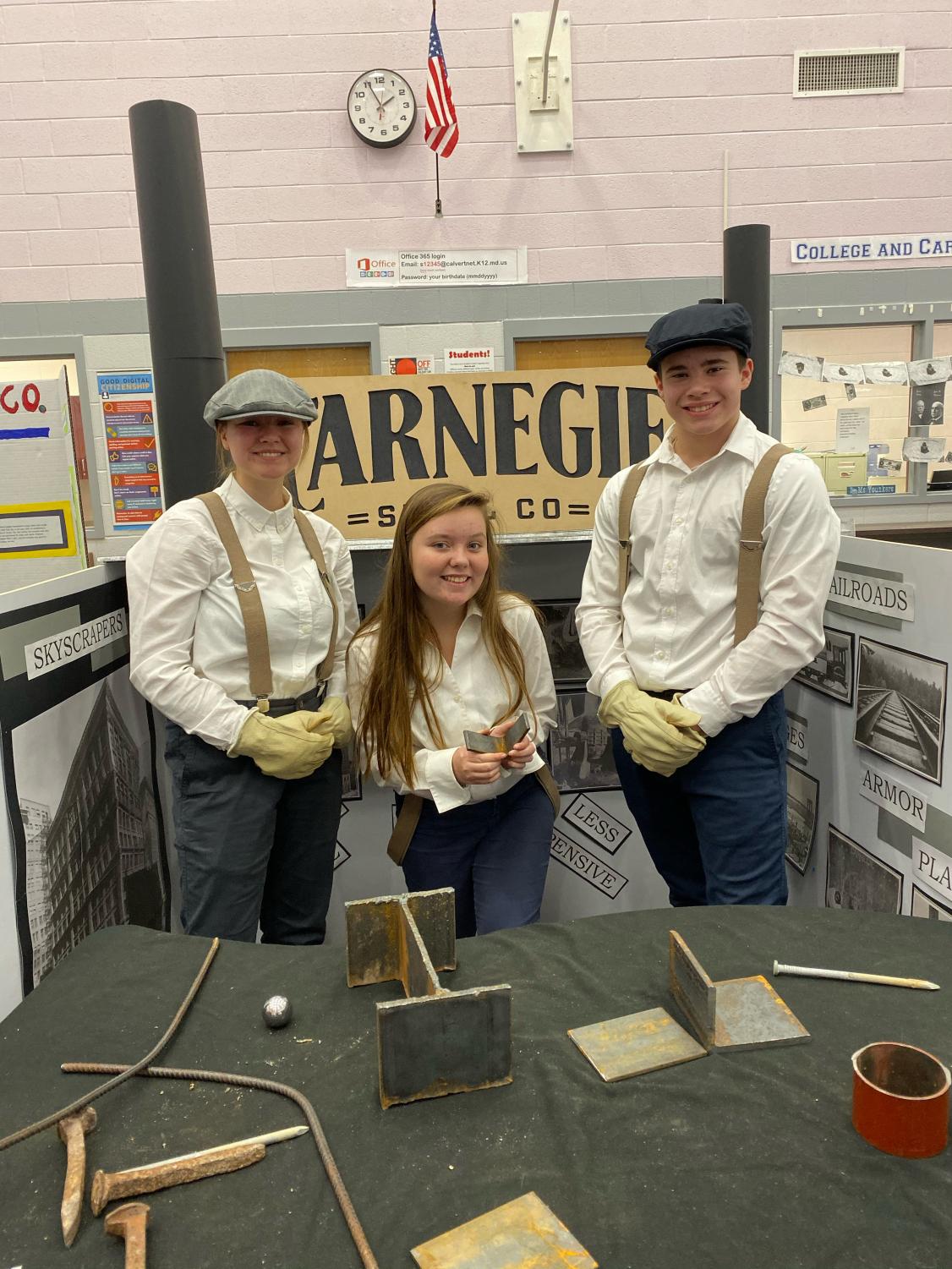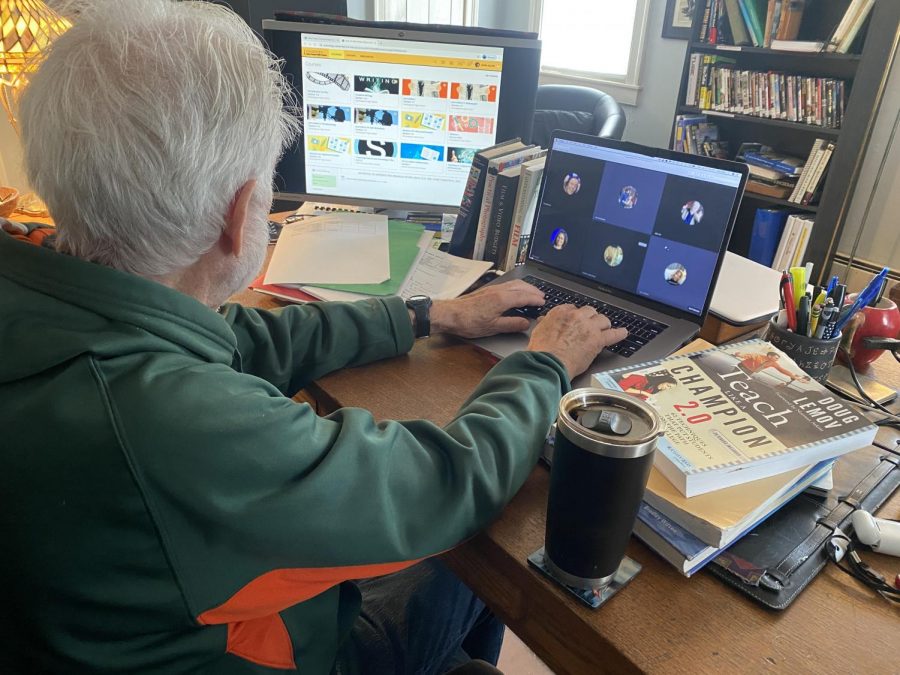We’re All In This Together
Online Instruction from the Teachers’ Point of View
January 18, 2021
When you really think about it, students and teachers aren’t all that different. After all, one of the many privileges of being a member of the human race is having things in common. And like us students, it may surprise you to know that teachers are facing their own struggles with online school, though they face it with admirable positivity and perseverance.
In a recent Forecast survey, the average enjoyment relating to online teaching was determined to be 3.16 out of 5 (most positive). Similarly, when asked about their stress levels compared to last Spring, the average is 3.26/5. Furthermore, multiple teachers anonymously expressed how fervently they miss their students. As a Junior who has not met a few of her teachers, the knowledge that my teachers were missing a student they hadn’t physically met warmed my heart immensely. “Seeing your faces and hearing your voices makes my day!” one teacher writes. Many more responses conclude how much our faces and voices improve their teaching. Another teacher reminds us, “I want them to know that I really am doing the best that I can. I would NEVER give them less than my all.” This kind of touching determination is evident in many replies that reiterate the sentiment: “We are in this together.” With this attitude in mind, let’s delve into the many struggles of online teaching. Here is everything they want you to know:
Cameras: Why Seeing a Face is so Important
93%. That’s roughly how may dentists recommend Crest toothpaste. Christopher Nolan’s critically acclaimed “Dunkirk” received 93 Rotten Tomatoes. It’s also the percentage that reflects the number of teachers who, to varying degrees, feel their connectivity with students is affected if we turn off our cameras. 93% of our teachers are struggling with the blank screens they see every day, and understandably so.

“I don’t think students understand how much teachers, in normal times, rely on student cues (facial expressions, body posture, movement) to shape and guide their instruction. In the current virtual model, we are operating without those cues.” Until this survey, I wasn’t aware of how our physical presence impacted our teachers’ abilities to educate. They depend on our faces to reflect our comprehension and engagement. They need to see if we received enough sleep the night before or if we’ve been having a difficult day. They almost depend on it. And if they can’t see anything, they aren’t able to cater to our needs.
Because of this notion, another teacher expresses how they would assign less work if there was more engagement, as participation equates understanding. “If they participated more and/or turned on their cameras, I would not feel the need to have every assignment turned in…. I would have more assurance that they are paying attention and retaining the material.” Many more teachers express the importance of participation, asking questions, and seeking help when needed. As they are not here to help us in person, other resources must be used in order to gain the fullest education possible.
The vast majority of teachers depend on connecting with their students, and many responses reflect this principle. For example:
“It’s frustrating to teach to an empty camera with no one on the other side!”
“Students having their camera on makes a huge difference and makes the lesson feel more valued.”
“It is really hard to build relationships when we don’t see them, and they rarely engage. We want to build the relationships and we are missing that part as well.”
Many more write how draining, boring, and frustrating it can be to have little face-to-face interactions with their students. These are but a few of the many responses expressing teachers’ desire to see their students’ faces. Cameras are the closest connection we have to a “normal” form of education, and as another teacher points out, “Students need to understand that their involvement directly correlates to how much they learn and enjoy this situation. If they keep their cameras off and don’t participate in the class, there’s nothing the teacher can do to improve the experience.”
The Overworking of Online Teachers
Students, we know what it’s like to feel overworked, but our teachers can more than empathize. When asked to rate their stress while teaching this year when compared to last year, the average number was conclusively 3.23/5. There are undoubtedly countless reasons for this overall increase in stress, but many teachers admitted this spike was due to their workload. One teacher writes, “I guess the hardest part [of teaching online] is conveying the amount of time, thought, and effort in developing lessons. There’s so much that goes on behind the scenes to prepare for every single lesson, every single day. I often wish I could show kids the various stages of development and the process for implementation.”
Similarly, another teacher explains the difficult process of creating their own assignments, formatting them to fit Schoology, and working well into the night, grading assignments. Additionally, there have been numerous struggles and mishaps with technology alone. A different educator reveals they work about 55 hours a week, which is a shocking 15 more than the average American high school teacher.
Furthermore, educators are feeling more rushed to teach the curriculum this year than in previous years, while many are simultaneously feeling behind. As one teacher writes, “For the pacing of the class, I have definitely covered less material. We currently are in Teams classes 2 1/2 hours a week with 1/2 hour of asynchronous learning a week. In a normal school year, we have 3 hours and 45 minutes of face-to-face class time each week. So, if I went through my material at the usual pace, I would have to cover material at a faster pace (with regards to the time I have with students). I think that may be one reason why many students think we are covering more material, but in reality, we are covering less material each week.”
Another teacher admits to having this same struggle: “I wish [students] understood how my planning time has tripled! I am working harder than I did in my first years of teaching. I wish they understood that if they spoke, turned cameras on and asked questions, class would go by faster…and they would ALL learn more!” Though our teachers are working much harder for better experiences online, they can only do so much without our help, which brings us to another online hardship:
Communication is Key
As I planned this particular survey for Huntingtown’s teachers, I expected a lot of valuable perspectives regarding students’ cameras, as well as our teachers’ increased workload. However, I was surprised to discover how many teachers are equally burdened by the lack of communication and feedback from their students. They deserve to know what works, what doesn’t work, and any other issues in order to educate us in the best way possible. One respondent writes, “I have no idea if they understand, are present, need more time, etc. because I cannot see them. It is so important for us to see students to gain feedback.”
Why is feedback so important, you may ask? Well, as one teacher words it, “We can’t make the experience better if we don’t know what’s working and what’s not.” As revealed in last issue’s article, Two Weeks, the majority of the student body seems to be struggling with online learning in one way or another. In this survey, many teachers reveal how eager they are to receive both positive and negative feedback, and such communication would assuredly improve circumstances for all.
Teachers aren’t the only ones feeling these repercussions; school counselors are too. While our counselors are still available to meet with students virtually and over the phone (during online education), there has been a noticeable decline in students reaching out for help. “I feel that some students think we are less approachable,” a counselor writes. “Because setting up a virtual time to talk with us takes more planning ahead and use of technology than before, when students could just drop by the guidance office, I feel we are seeing less of our students overall than we did last year; but I want them to know to please sign up to talk with us – we are here to support students and we love talking with students.”
Our teachers and staff want to help us, so we should let them. Many teachers are encouraging students to take advantage of resources, reach out for help, and do anything else to improve our experiences. And I firmly believe we have the power to make this experience a lot greater than we initially thought possible.

We Miss You Too!
I promised I would tell you everything teachers want you to know, and I plan to deliver. Above all else, our teachers’ responses consistently voiced how much they miss us and how excited they are to see us again. Here are a few particularly touching responses:
“I truly hope that students know how much we care about them and that we miss them and look forward to seeing them!”
“As a teacher, I miss everything about being in school together. I can’t wait until this is behind us & the Cane Family is back under one roof together!”
“Despite this challenging year, I would choose to wake up and teach every single day. I love students, I love reading/writing, I love teaching – in whatever way that means.”
“I am really proud of you and how well you are handling this situation. You make our world a better place. Keep up the good work.”
Teachers, we acknowledge your hard work, determination, patience, and above all, your passion to help us learn. We sincerely thank you for everything you do for us, because believe me when I say we miss you too!

